A Study on Synoptic Conditions Leading to the Extreme Rainfall in Taiwan during 10–12 June 2012
Abstract
1. Introduction
2. Data and Methodology
2.1. Data
2.2. Methodology and the Pressure Tendency Equation
3. Analysis on Synoptic Evolution
3.1. Position of Mei-yu Front during Heavy Rainfall
3.2. Pressure Fall in South China and Synoptic Evolution
4. Diagnosis of Low-Level Pressure Tendency
5. Discussion
5.1. Temperature Advection
5.2. Thermodynamic Structure and Stability
5.3. Dynamic Processes in Mass Transport
6. Conclusions
- (i)
- The analysis indicates that the heavy rainfall with such a long duration in Taiwan was due to a strong and persistent west-southwesterly LLJ that transported warm, moist, and unstable air from the upstream area, and then impinged on the topography of the island. The LLJ developed in response to an enhancement in the horizontal pressure (or geopotential height) gradient, when the pressure at low-levels fell significantly, by about 8 hPa, to the north of the jet in South China during a 66 h period on 8–10 June, but the STH to the southeast remained and did not retreat much.
- (ii)
- Through diagnosis using the pressure tendency equation, it is found that the persistent warm air advection through deep troposphere (mainly above 800 hPa) was a major contributor toward the pressure fall in South China during 8–10 June. From before the pressure fall period, a large-scale confluent pattern existed in China, and provided west-southwesterly flow and warm air advection in South China, thus transporting warmer and less dense air into the region from lower latitudes. While the effect of warm advection was even stronger during 5–7 June (before the fall period), it somewhat weakened during the fall period (8–10 June) but was still the main driver to pressure decrease on 8 and 10 June 2012.
- (iii)
- In the upper troposphere, the South Asian anticyclone had its center to the southwest of South China, and thus provided persistent upper-level divergence before and during the fall period (5–10 June), since South China was located in its northeastern quadrant with significant flow diffluence. During 5–10 June, the South Asian anticyclone and its associated divergence also strengthened, and with increased potential (or convective) instability and more vigorous convection development in South China, the divergence aloft was able to exceed low-level convergence to produce net mass outflow in the air column, and further at least cancel out the effect of rising motion (toward pressure rise) during 8–10 June. On 9 June, the two dynamic terms (convergence/divergence effect and vertical motion) in combination even contributed more than the warm air advection toward the pressure fall.
Author Contributions
Funding
Data Availability Statement
Acknowledgments
Conflicts of Interest
References
- Ding, Y.-H. Summer monsoon rainfalls in China. J. Meteor. Soc. Jpn. 1992, 70, 337–396. [Google Scholar] [CrossRef]
- Chen, G.T.-J. Observational aspects of Mei-yu phenomena in subtropical China. J. Meteor. Soc. Jpn. 1983, 61, 306–312. [Google Scholar] [CrossRef]
- Tao, S.; Chen, L. A review of recent research on the East Asian summer monsoon in China. In Monsoon Meteorology; Chang, C.-P., Krishnamurti, T.N., Eds.; Oxford University Press: Oxford, UK, 1987; pp. 60–92. [Google Scholar]
- Lau, K.-M.; Yang, G.J.; Shen, S.H. Seasonal and intraseasonal climatology of summer monsoon rainfall over East Asia. Mon. Weather Rev. 1988, 116, 18–37. [Google Scholar] [CrossRef]
- Chen, Y.-L. Some synoptic-scale aspects of surface fronts over southern China during TAMEX. Mon. Weather Rev. 1993, 121, 50–64. [Google Scholar] [CrossRef]
- Chen, C.-S.; Chen, Y.-L. The Rainfall Characteristics of Taiwan. Mon. Weather Rev. 2003, 131, 1323–1341. [Google Scholar] [CrossRef]
- Chen, G.T.-J.; Tsay, C.-Y. A synoptic case study of Mei-Yu near Taiwan. Papers Meteor. Res. 1978, 1, 25–36. [Google Scholar]
- Chen, G.T.-J. On the moisture budget of a Mei-Yu system in southeastern Asia. Proc. Natl. Sci. Counc. 1979, 3, 24–32. [Google Scholar]
- Chen, G.T.-J.; Chi, S.-S. On the meso-scale structure of Mei-Yu front in Taiwan. Atmos. Sci. 1978, 5, 35–47, (In Chinese with English Abstract). [Google Scholar]
- Chen, G.T.-J.; Yu, C.-C. Role of Mei-Yu front and mesolow on the heavy rainfall events. Two cases in TAMEX Phase I (1986). Atmos. Sci. 1990, 18, 129–147, (In Chinese with English Abstract). [Google Scholar]
- Li, J.; Chen, Y.-L.; Lee, W.-C. Analysis of a heavy rainfall event during TAMEX. Mon. Weather Rev. 1997, 125, 1060–1081. [Google Scholar] [CrossRef]
- Chen, C.; Tao, W.-K.; Lin, P.-L.; Lai, G.S.; Tseng, S.-F.; Wang, T.-C.C. Wang. The intensification of the low-level jet during the development of mesoscale convective systems on a Mei-Yu front. Mon. Weather Rev. 1998, 126, 349–371. [Google Scholar] [CrossRef]
- Chen, S.-J.; Kuo, Y.-H.; Wang, W.; Tao, Z.-Y.; Cuo, B. A modeling case study of heavy rainstorms along the Mei-Yu front. Mon. Weather Rev. 1998, 126, 2330–2351. [Google Scholar] [CrossRef]
- Chen, S.-J.; Wang, W.; Lau, K.H.; Zhang, Q.H.; Chung, Y.S. Mesoscale convective systems along the Meiyu front in a numerical model. Meteor. Atmos. Phys. 2000, 75, 149–160. [Google Scholar] [CrossRef]
- Chen, X.A.; Chen, Y.-L. 1995: Development of low-level jets during TAMEX. Mon. Weather Rev. 1995, 123, 1695–1719. [Google Scholar] [CrossRef]
- Chen, G.T.-J.; Chang, C.-P. The structure and vorticity budget of an early summer monsoon trough (mei-yu) over southeastern China and Japan. Mon. Weather Rev. 1980, 108, 942–953. [Google Scholar] [CrossRef]
- Chen, G.T.-J.; Wang, C.-C.; Liu, S.C.-S. Potential vorticity diagnostics of a Mei-yu front case. Mon. Weather Rev. 2003, 131, 2680–2696. [Google Scholar] [CrossRef]
- Chen, G.T.-J.; Wang, C.-C.; Lin, L.-F. A diagnostic study of a retreating Mei-Yu front and the accompanying low-level jet formation and intensification. Mon. Weather Rev. 2006, 134, 874–896. [Google Scholar] [CrossRef]
- Chen, G.T.-J.; Wang, C.-C.; Chang, S.-W. A diagnostic case study of Mei-yu frontogenesis and development of wavelike frontal disturbances in the subtropical environment. Mon. Weather Rev. 2008, 136, 41–61. [Google Scholar] [CrossRef]
- Cho, H.-R.; Chen, G.T.-J. Mei-yu frontogenesis. J. Atmos. Sci. 1995, 52, 2109–2120. [Google Scholar] [CrossRef]
- Chien, F.-C.; Hung, Y.-H. Composite and numerical studies of southwesterly flow in the Taiwan area during Mei-yu seasons. Atmos. Sci. 2010, 38, 237–267, (In Chinese with English Abstract). [Google Scholar]
- Chen, G.T.-J. Large-scale circulations associated with the East Asian summer monsoon and the Mei-Yu over South China and Taiwan. J. Meteor. Soc. Jpn. 1994, 72, 959–983. [Google Scholar] [CrossRef]
- Wang, C.-C.; Chiou, B.-K.; Chen, G.T.-J.; Kuo, H.-C.; Liu, C.-H. A numerical study of back-building process in a quasistationary rainband with extreme rainfall over northern Taiwan during 11–12 June 2012. Atmos. Chem. Phys. 2016, 16, 12359–12382. [Google Scholar] [CrossRef]
- Chen, Y.-L.; Chu, Y.-J.; Chen, C.-S.; Tu, C.-C.; Teng, J.-H.; Lin, P.-L. Analysis and simulations of a heavy rainfall event over northern Taiwan during 11–12 June 2012. Mon. Weather Rev. 2018, 146, 2697–2715. [Google Scholar] [CrossRef]
- Dee, D.P.; Uppala, S.M.; Simmons, A.J.; Berrisford, P.; Poli, P.; Kobayashi, S.; Andrae, U.; Balmaseda, M.A.; Balsamo, G.; Bauer, D.P.; et al. The ERA-Interim reanalysis: Configuration and performance of the data assimilation system. Quart. J. Roy. Meteor. Soc. 2011, 137, 553–597. [Google Scholar] [CrossRef]
- Huffman, G.J.; Adler, R.F.; Bolvin, D.T.; Gu, G.; Nelkin, E.J.; Bowman, K.P.; Hong, Y.; Stocker, E.F.; Wolff, D.B. The TRMM Multisatellite Precipitation Analysis (TMPA): Quasi-global, multiyear, combined-Sensor precipitation estimates at fine scales. J. Hydrometeorl. 2007, 8, 38–55. [Google Scholar] [CrossRef]
- Hsu, J. ARMTS up and running in Taiwan. Väisälä News 1998, 146, 24–26. [Google Scholar]
- Gettelman, A.; de F Forster, P.M. A climatology of the tropical tropopause layer. J. Meteor. Soc. Jpn. 2002, 80, 911–924. [Google Scholar] [CrossRef]
- Fueglistaler, S.; Dessler, A.E.; Dunkerton, T.J.; Folkins, I.; Fu, Q.; Mote, P.W. Tropical tropopause layer. Rev. Geophys. 2009, 47, RG1004. [Google Scholar] [CrossRef]
- Chen, Y.-L.; Li, J. Large-scale conditions favorable for the development of heavy rainfall during TAMEX. Mon. Weather Rev. 1995, 123, 2978–3002. [Google Scholar] [CrossRef][Green Version]
- Chen, C.-S.; Chen, W.-C.; Chen, Y.-L.; Lin, P.-L.; Lai, H.-C. Investigation of orographic effects on two heavy rainfall events over southwestern Taiwan during the Mei-yu season. Atmos. Res. 2005, 73, 101–130. [Google Scholar] [CrossRef]
- Wang, C.-C.; Hsu, J.C.-S.; Chen, G.T.-J.; Lee, D.-I. A study of two propagating heavy-rainfall episodes near Taiwan during SoWMEX/TiMREX IOP-8 in June 2008. Part I: Synoptic evolution, episode propagation, and model control simulation. Mon. Weather Rev. 2014, 142, 2619–2643. [Google Scholar] [CrossRef]
- Wang, C.-C.; Hsu, J.C.-S.; Chen, G.T.-J.; Lee, D.-I. A study of two propagating heavy-rainfall episodes near Taiwan during SoWMEX/TiMREX IOP-8 in June 2008. Part II: Sensitivity tests on the roles of synoptic conditions and topographic effects. Mon. Weather Rev. 2014, 142, 2644–2664. [Google Scholar] [CrossRef]
- Wang, C.-C.; Chen, G.T.-J.; Ngai, C.-H.; Tsuboki, K. Case study of a morning convective rainfall event over southwestern Taiwan in the Mei-yu season under weak synoptic conditions. J. Meteor. Soc. Jpn. 2018, 96, 461–484. [Google Scholar] [CrossRef]
- Wang, C.-C.; Chen, G.T.-J.; Ho, K.-H. A diagnostic case study of mei-yu frontal retreat and associated low development near Taiwan. Mon. Weather Rev. 2016, 144, 2327–2349. [Google Scholar] [CrossRef]
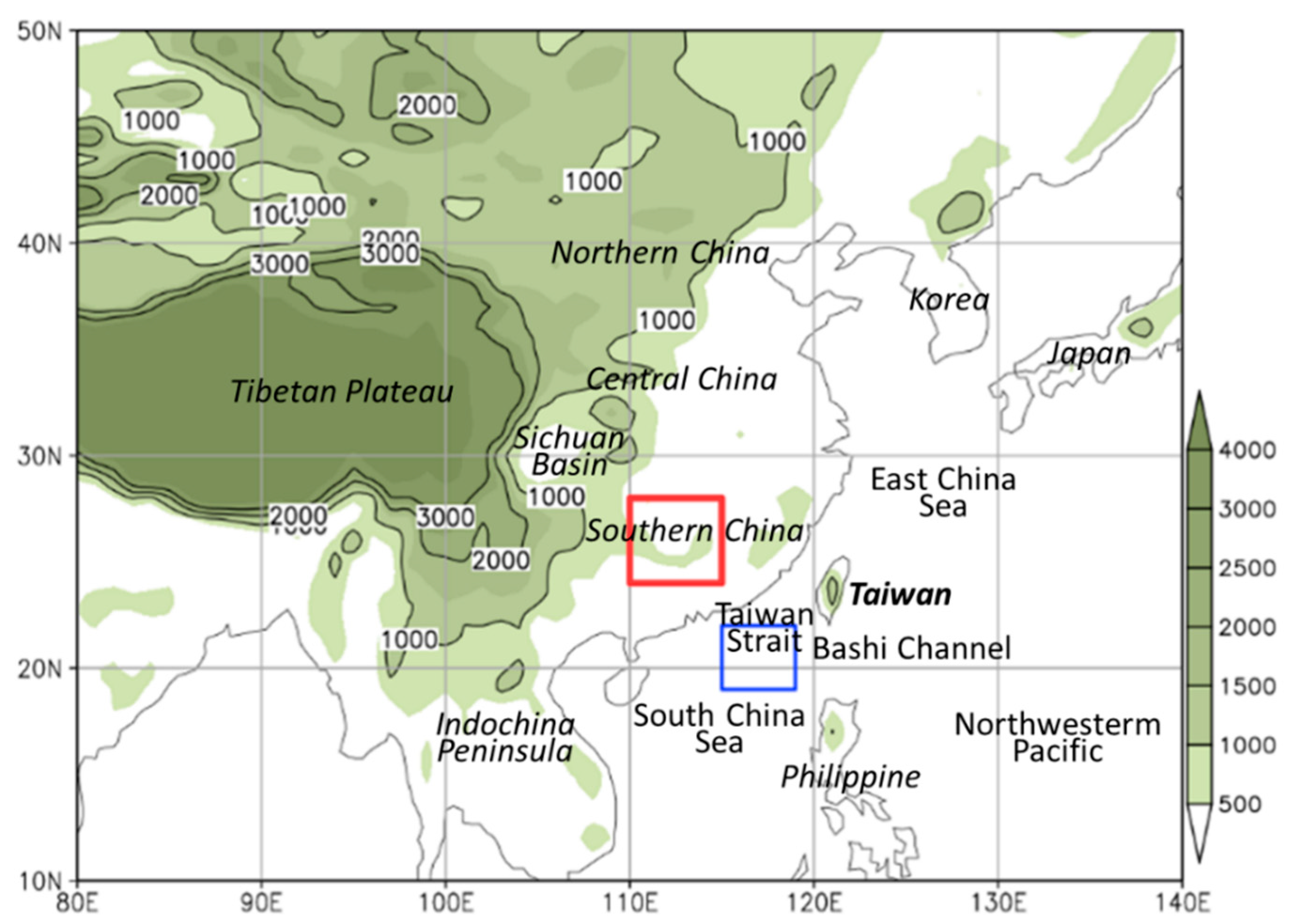
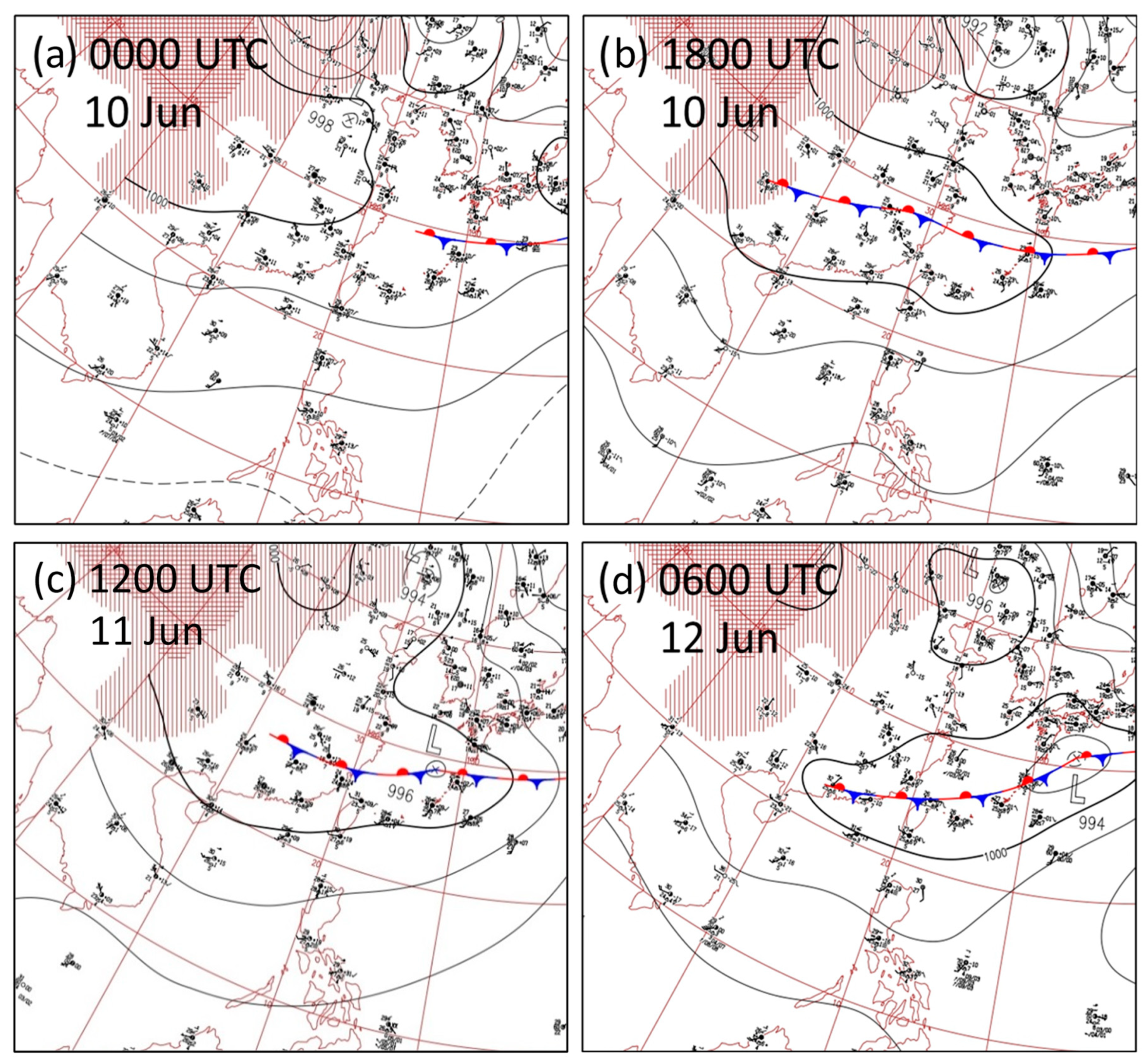

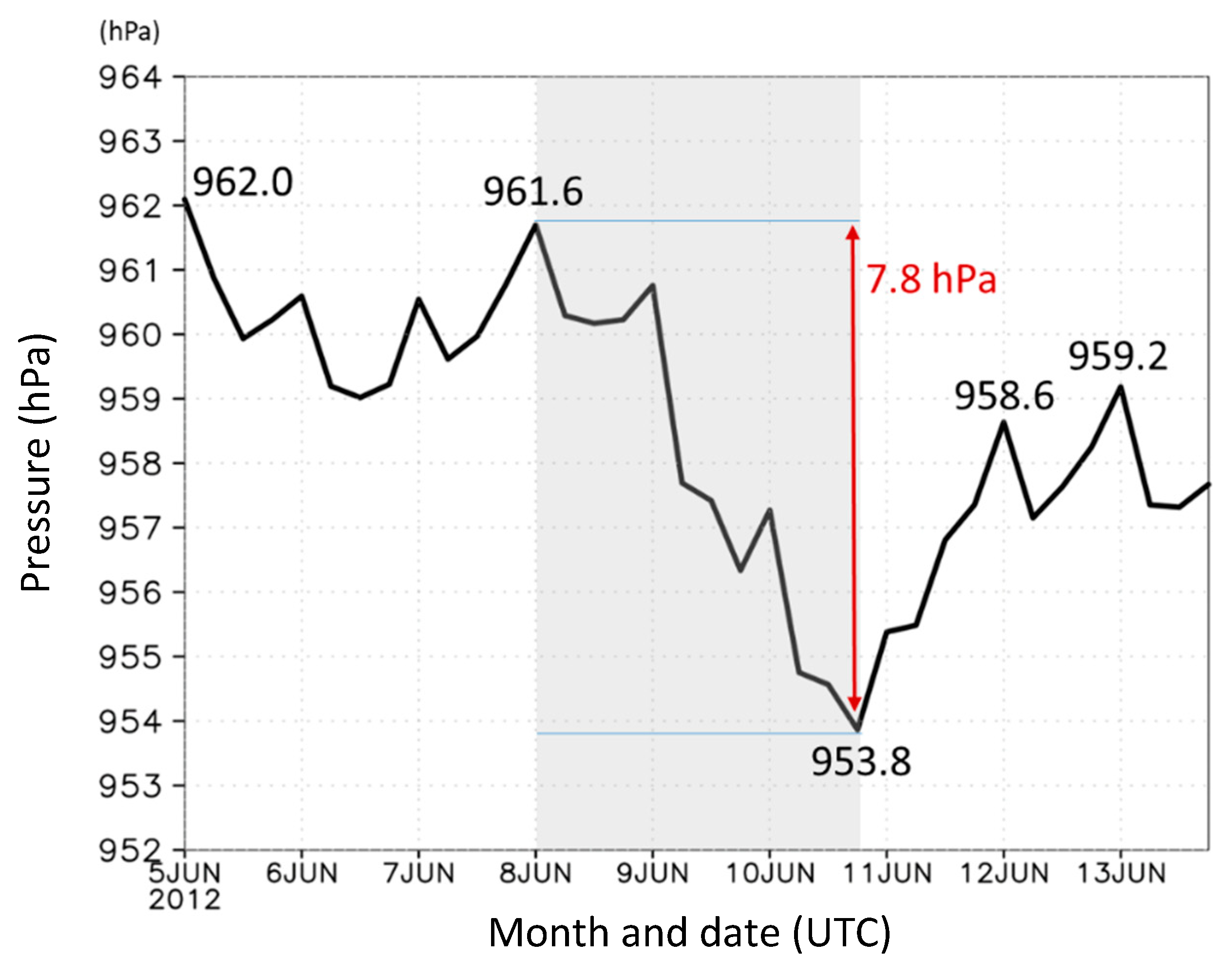
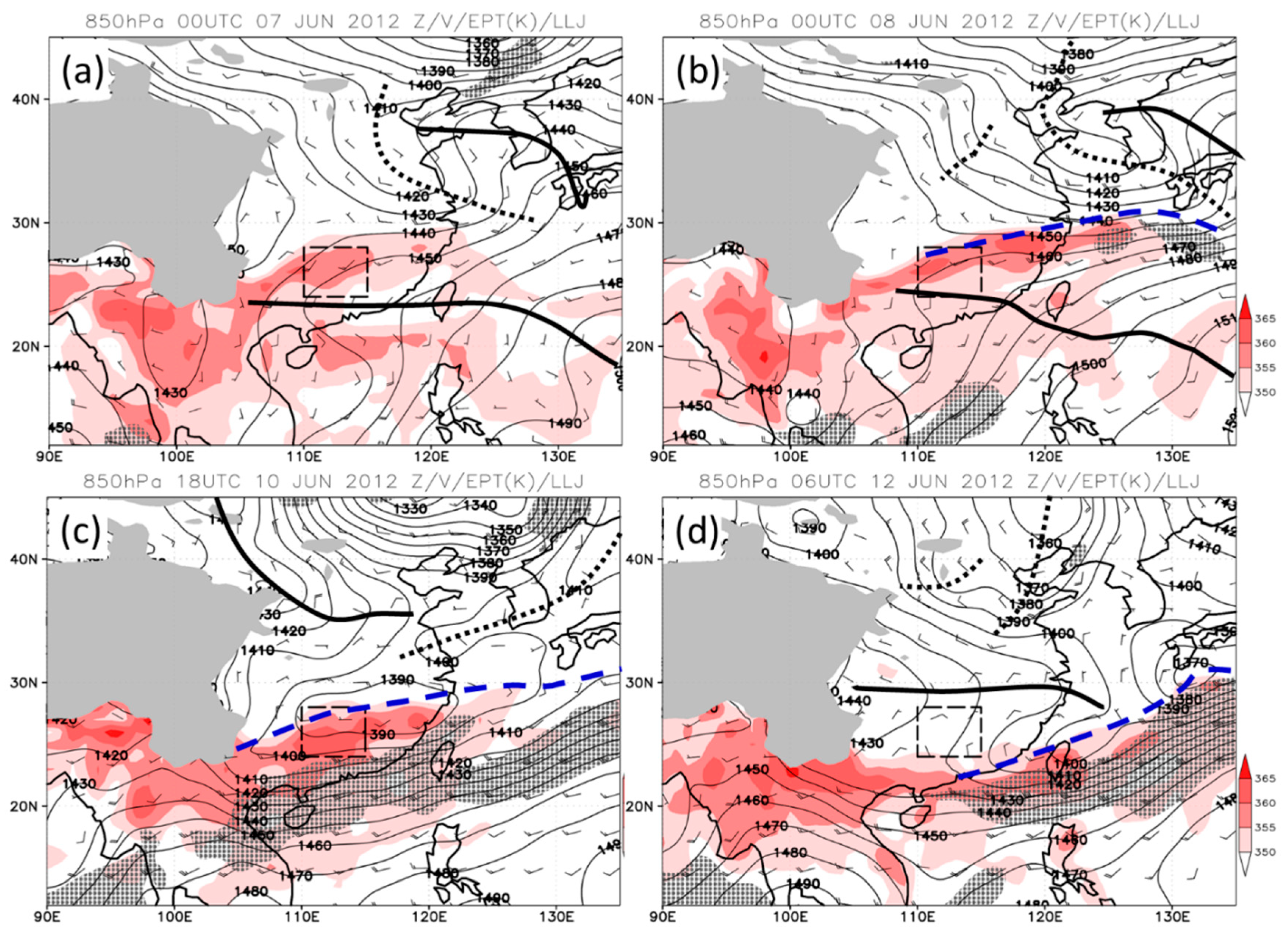
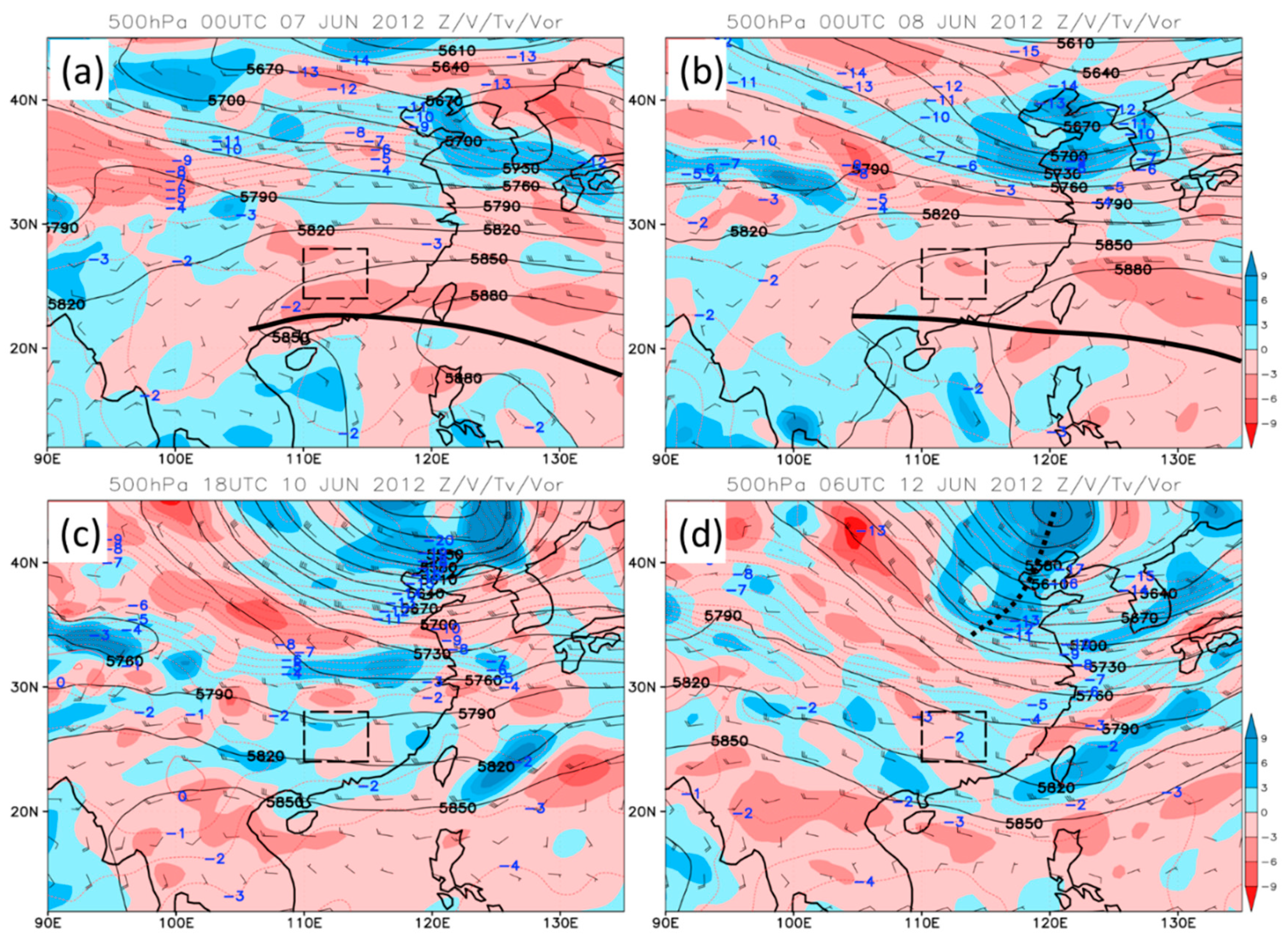
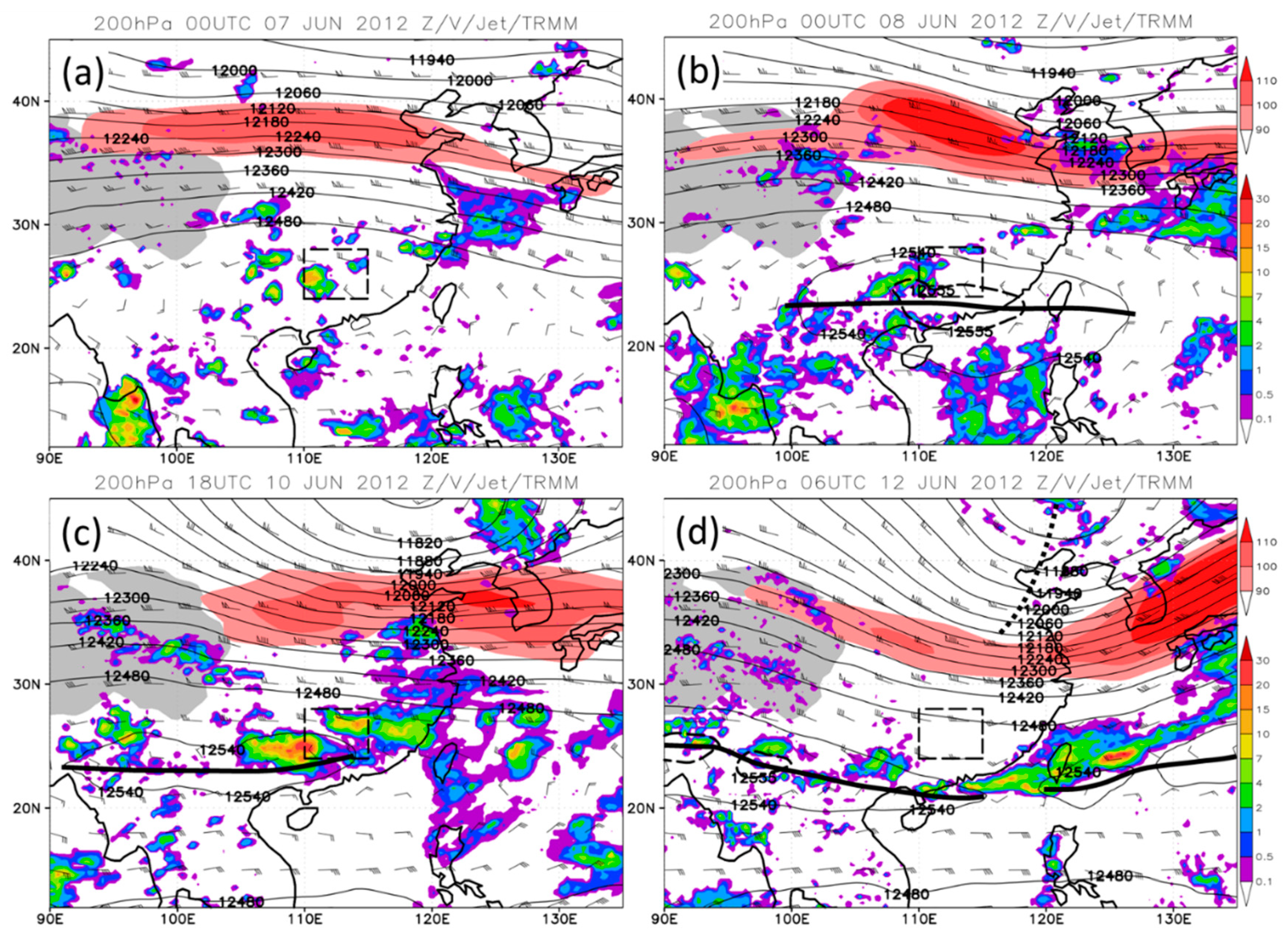
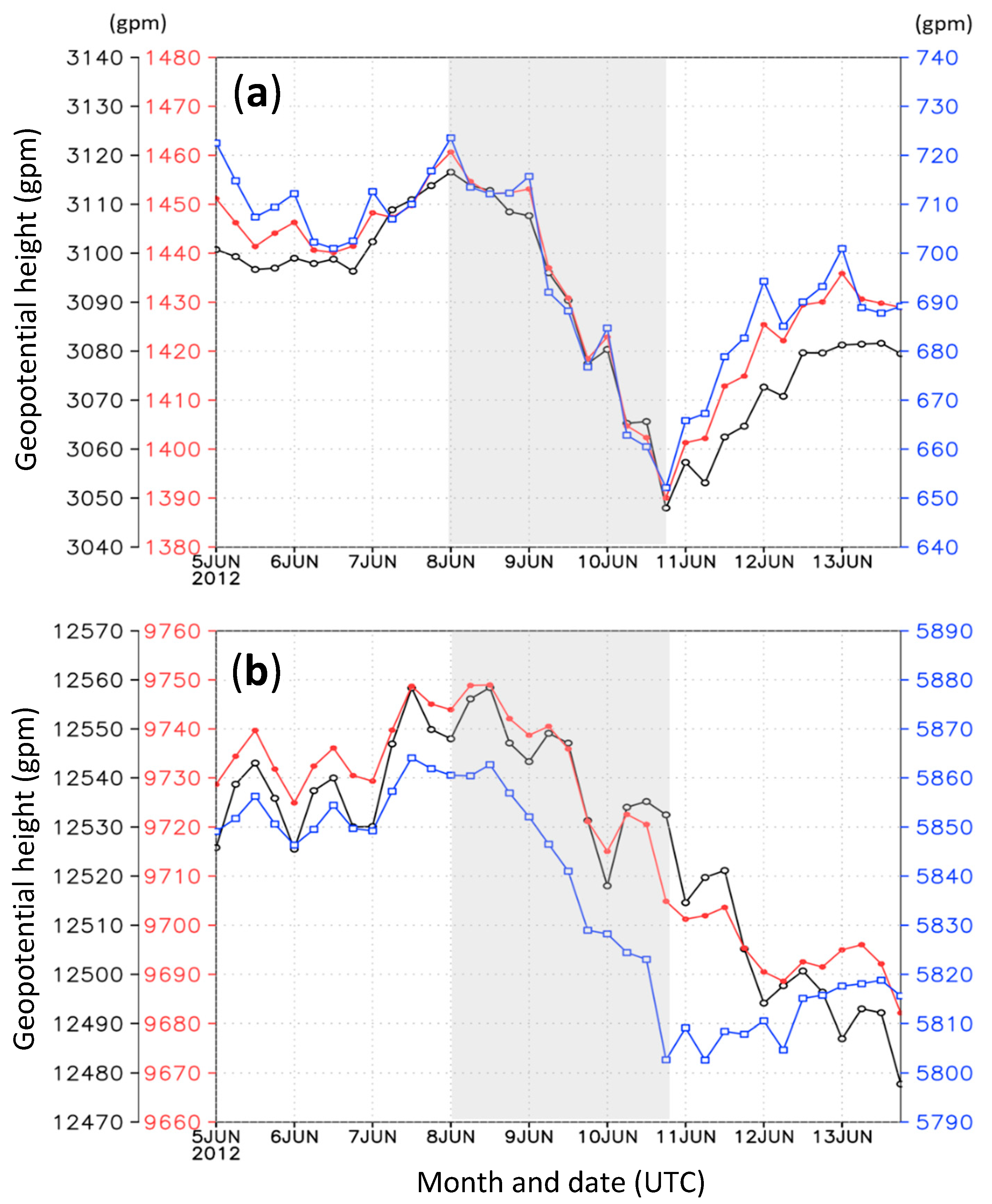
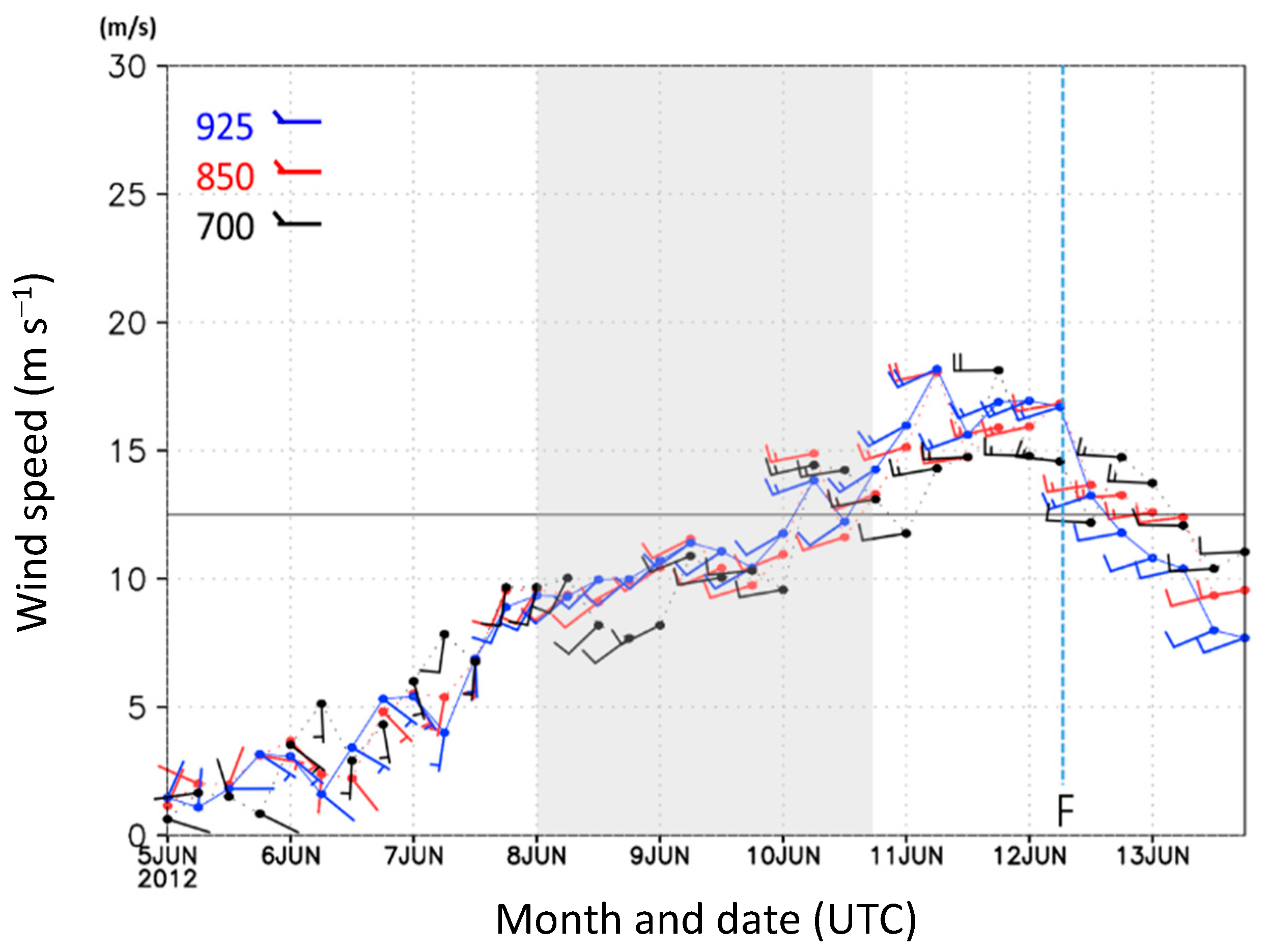
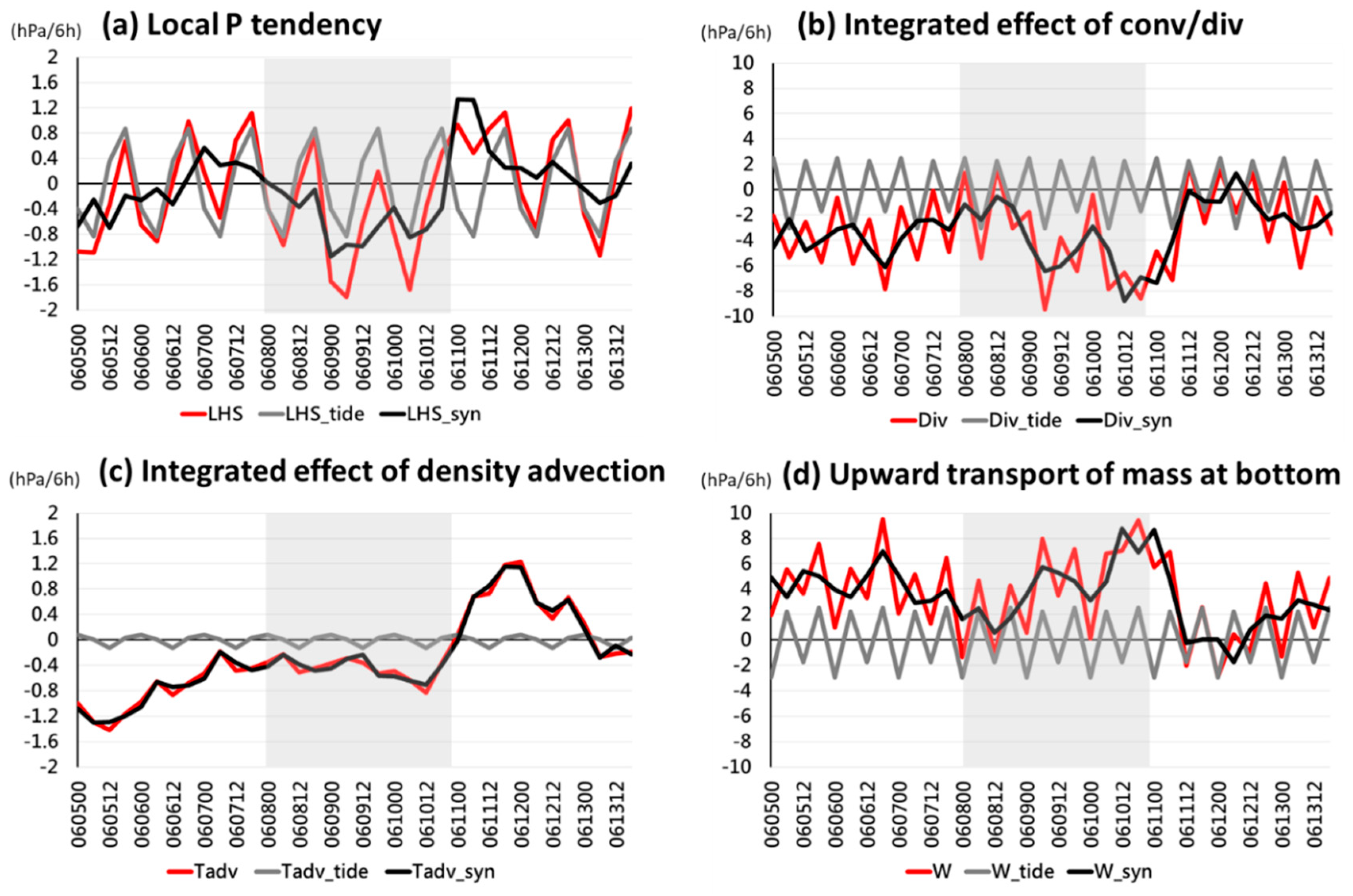
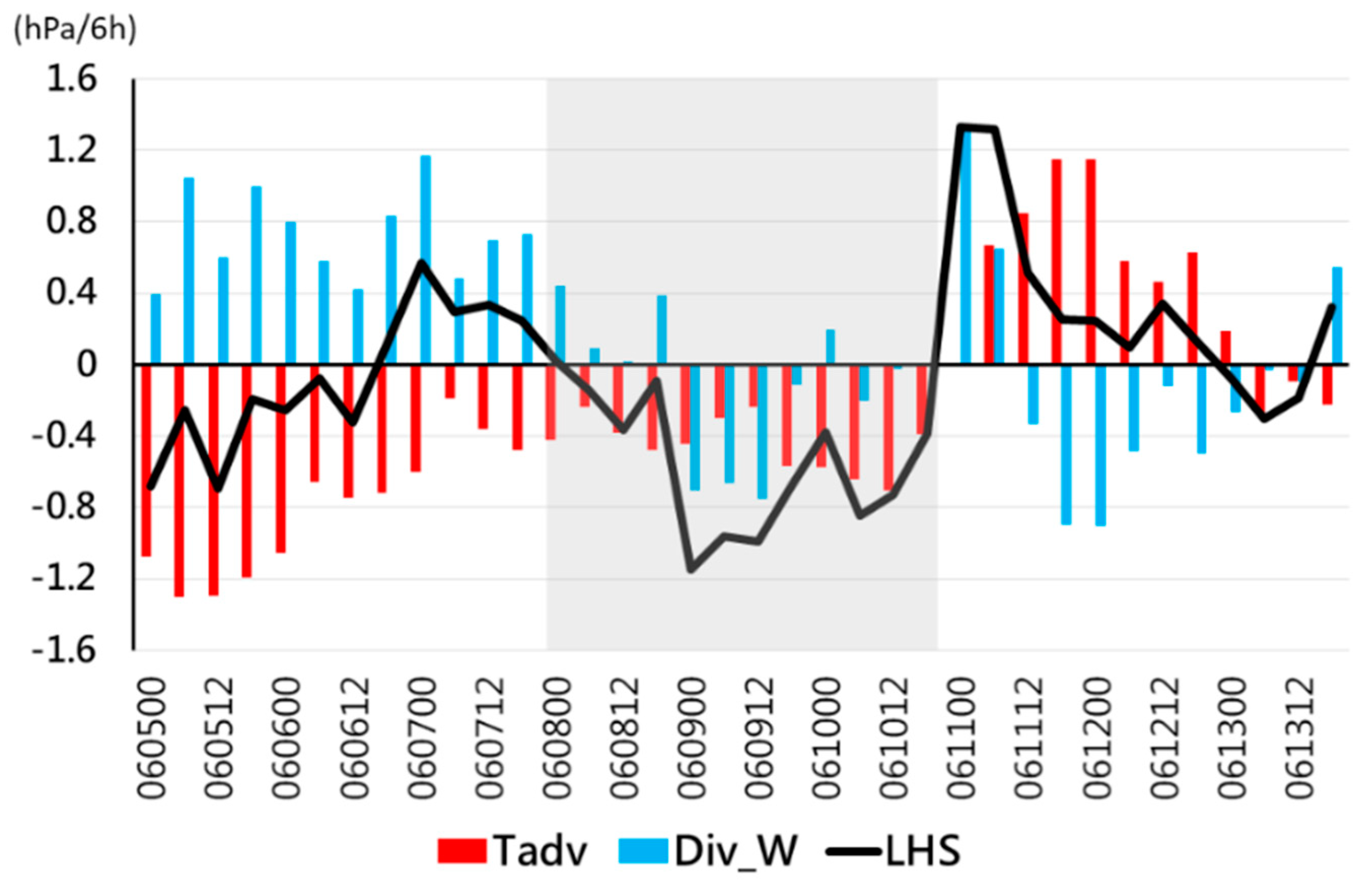
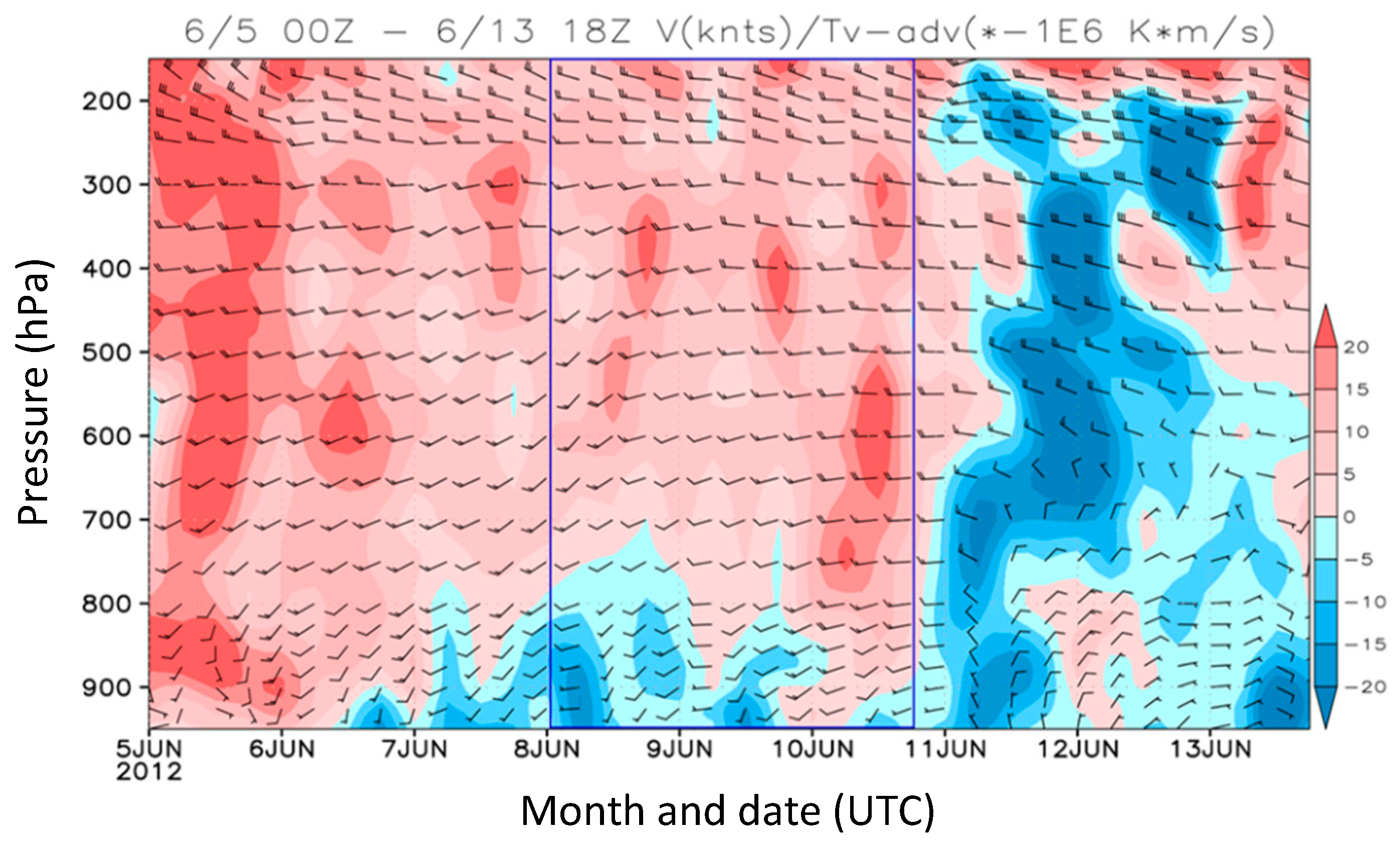
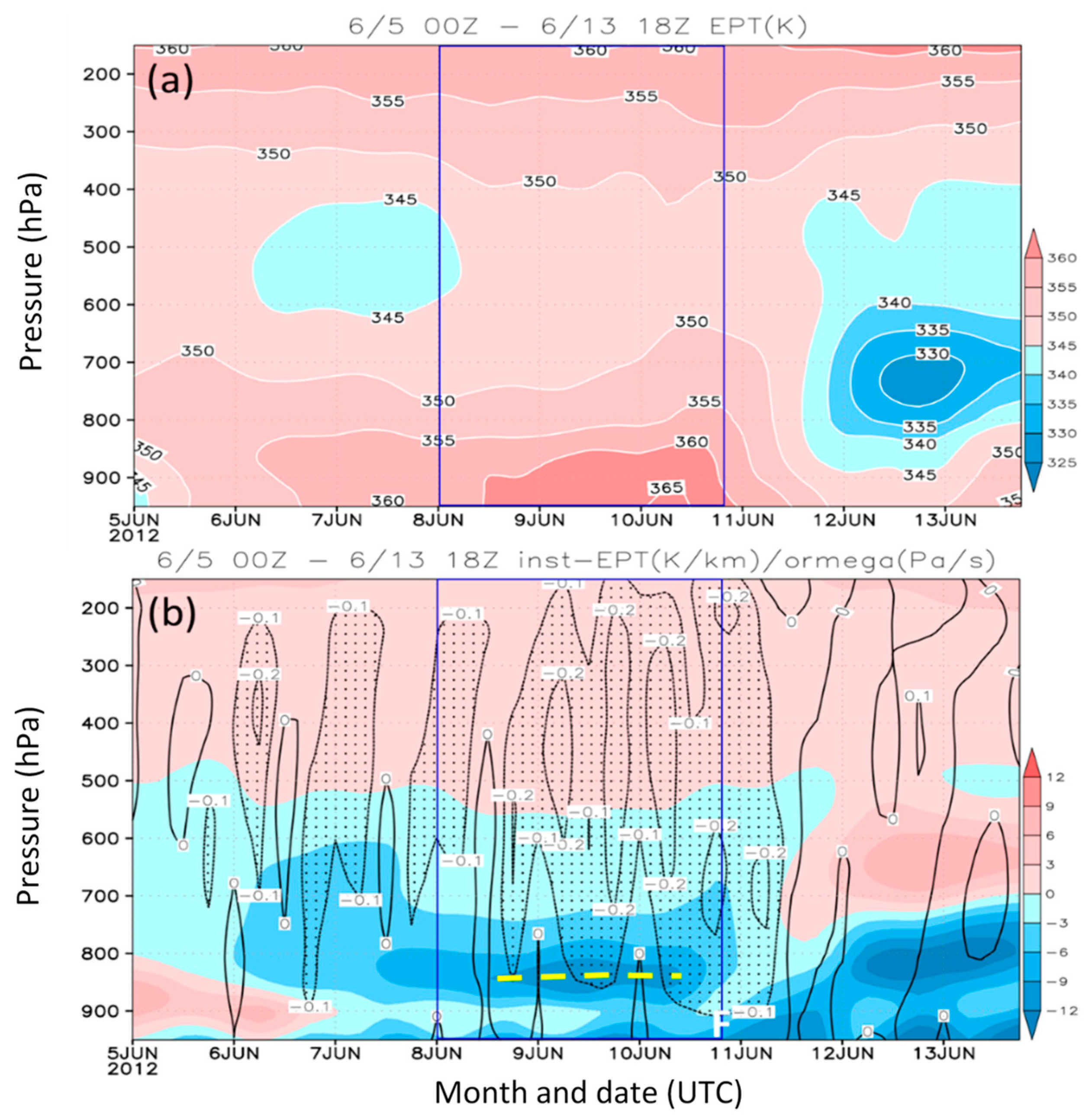
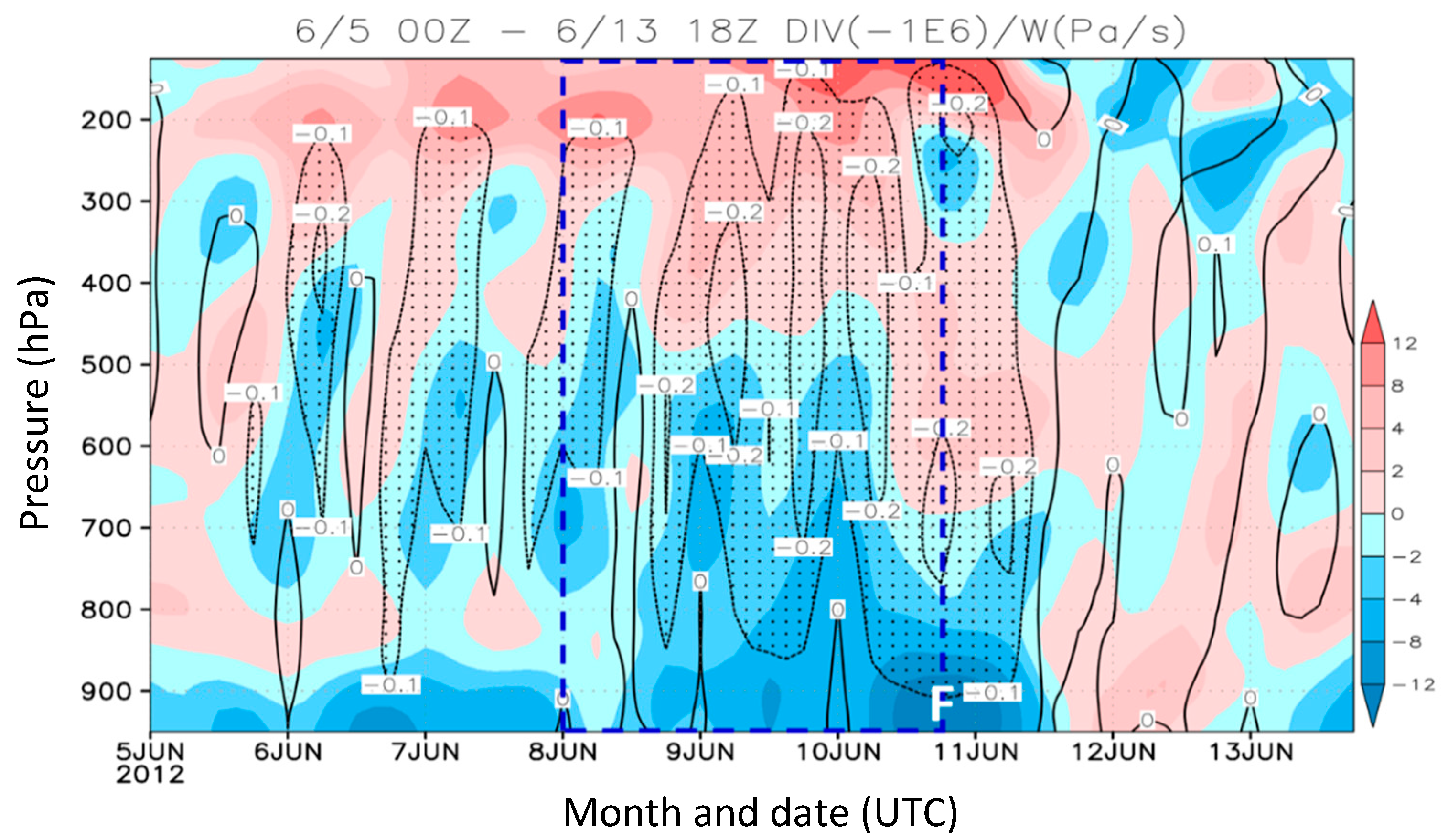
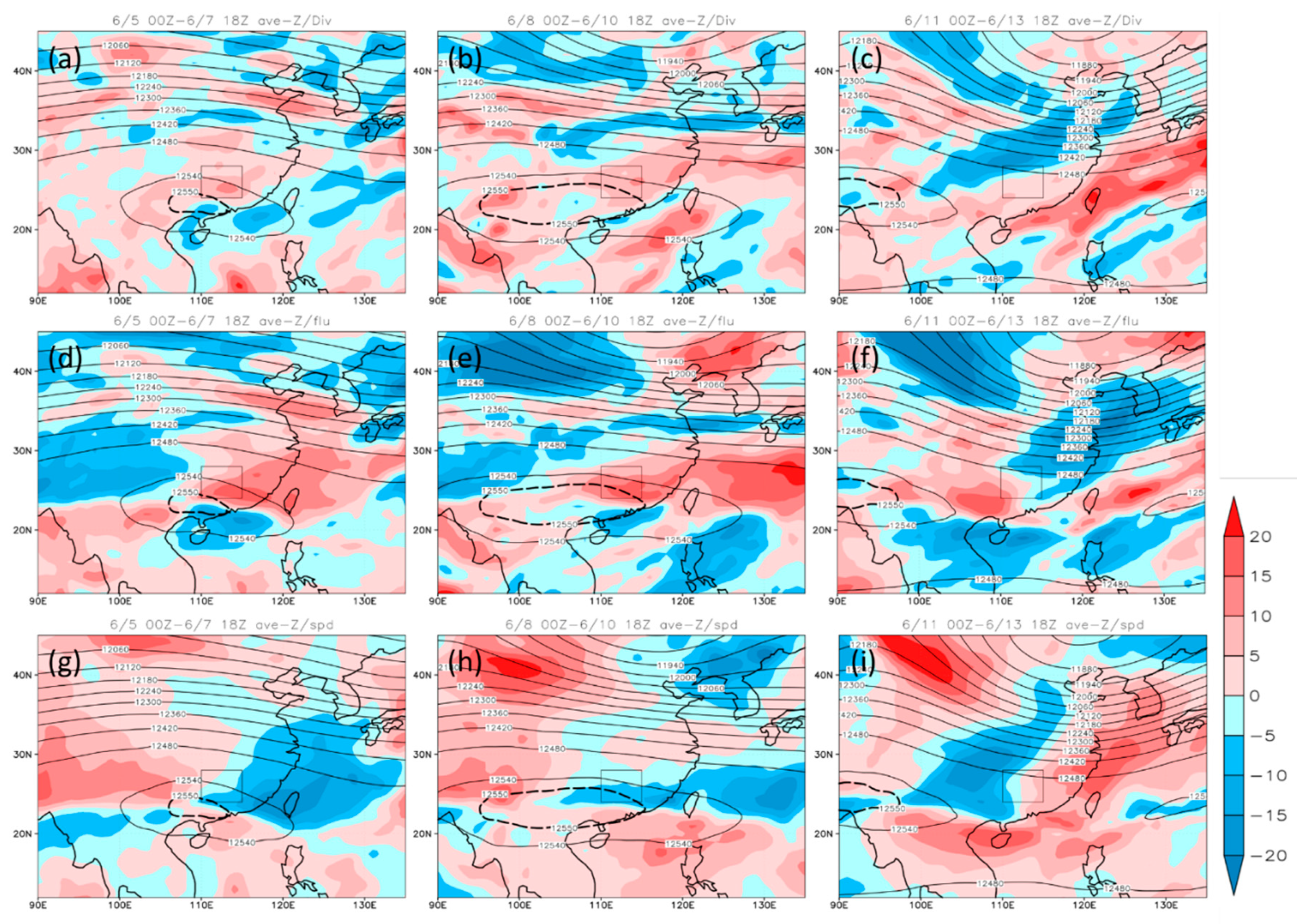
| Year and Month | Date | No. of Gauges ≥350 mm | Time of Front to Reach Northern Taiwan |
|---|---|---|---|
| 2005, June | 12 | 10 | 0600 UTC 12 June 2005 |
| 13 | 4 | ||
| 14 | 8 | ||
| 15 | 2 | ||
| 2006, June | 8 | 1 | 1200 UTC 8 June 2006 |
| 9 | 35 | ||
| 10 | 7 | ||
| 2012, June | 10 | 13 | 0600 UTC 12 June 2012 |
| 11 | 15 | ||
| 12 | 14 |
Publisher’s Note: MDPI stays neutral with regard to jurisdictional claims in published maps and institutional affiliations. |
© 2021 by the authors. Licensee MDPI, Basel, Switzerland. This article is an open access article distributed under the terms and conditions of the Creative Commons Attribution (CC BY) license (https://creativecommons.org/licenses/by/4.0/).
Share and Cite
Wang, A.-H.; Wang, C.-C.; Chen, G.T.-J. A Study on Synoptic Conditions Leading to the Extreme Rainfall in Taiwan during 10–12 June 2012. Atmosphere 2021, 12, 1255. https://doi.org/10.3390/atmos12101255
Wang A-H, Wang C-C, Chen GT-J. A Study on Synoptic Conditions Leading to the Extreme Rainfall in Taiwan during 10–12 June 2012. Atmosphere. 2021; 12(10):1255. https://doi.org/10.3390/atmos12101255
Chicago/Turabian StyleWang, An-Hsiang, Chung-Chieh Wang, and George Tai-Jen Chen. 2021. "A Study on Synoptic Conditions Leading to the Extreme Rainfall in Taiwan during 10–12 June 2012" Atmosphere 12, no. 10: 1255. https://doi.org/10.3390/atmos12101255
APA StyleWang, A.-H., Wang, C.-C., & Chen, G. T.-J. (2021). A Study on Synoptic Conditions Leading to the Extreme Rainfall in Taiwan during 10–12 June 2012. Atmosphere, 12(10), 1255. https://doi.org/10.3390/atmos12101255






